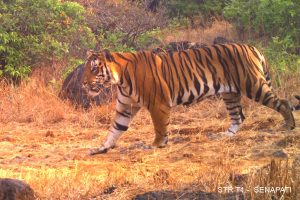By | Pravin Kadam
Satara – In a unique display of pride and connection with their wildlife heritage, local communities around the Sahyadri Tiger Reserve (STR) have given popular names to three resident male tigers. The tigers, earlier known only by their official coded numbers, will now be fondly remembered as ‘Senapati’ (STR-T1), ‘Subedar’ (STR-T2), and ‘Baji’ (STR-T3).
Inspired by the titles of Maratha warriors who fought alongside Chhatrapati Shivaji Maharaj, these names highlight the deep cultural bond between the region’s history and its wildlife. Forest guides, workers, and nature enthusiasts had been using these names informally for years, and the Forest Department has now formally recognized them to create stronger public interest and emotional attachment.
⭕ Currently, STR is home to three male tigers:

Kiran Jagtap, Deputy Director, Sahyadri Tiger Reserve, Koyna
STR-T1 ‘Senapati’ – first recorded in December 2023, five years after the last tiger sighting in the reserve.
STR-T2 ‘Subedar’ – originally captured on camera in Radhanagari Wildlife Sanctuary in 2022, later spotted migrating to Sahyadri in October 2024.
STR-T3 ‘Baji’ – first documented in Kolhapur’s Kadgaon forest in 2023 and recorded in Sahyadri in 2025, also known to have traveled through Chiplun forests in Konkan.
At present, Senapati and Subedar reside in Chandoli National Park, while Baji roams in Koyna Wildlife Sanctuary.
Forest officials believe that giving tigers locally inspired names helps strengthen conservation awareness.
Meanwhile, preparations are underway for ‘Operation Tara’, under which tigresses from Pench and Tadoba-Andhari Tiger Reserves will be relocated to Sahyadri. This scientific initiative is expected to boost biodiversity, create a balanced tiger ecosystem, and ensure the long-term survival of the species in Western Maharashtra.

The Sahyadri Tiger Reserve, spread across Satara, Kolhapur, and Sangli districts, is one of Maharashtra’s most ambitious conservation projects. Officials emphasize that along with tiger protection, the reserve will help safeguard forests, wildlife, and crucial water sources of the region.








